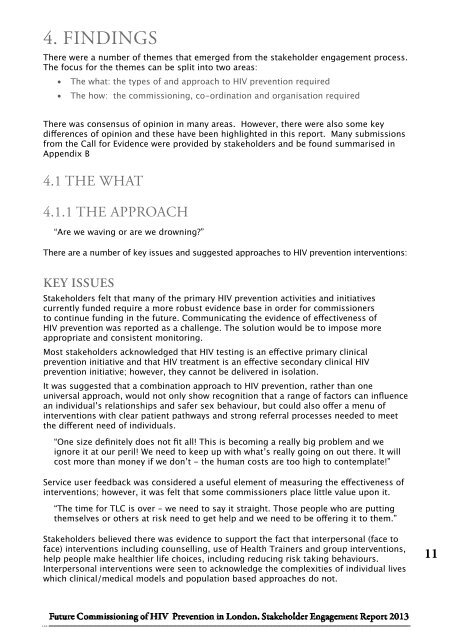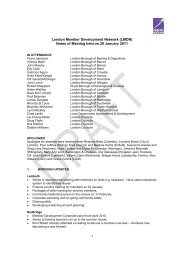Stakeholder Engagement Report - London Councils
Stakeholder Engagement Report - London Councils
Stakeholder Engagement Report - London Councils
You also want an ePaper? Increase the reach of your titles
YUMPU automatically turns print PDFs into web optimized ePapers that Google loves.
4. Findings<br />
There were a number of themes that emerged from the stakeholder engagement process.<br />
The focus for the themes can be split into two areas:<br />
• The what: the types of and approach to HIV prevention required<br />
• The how: the commissioning, co-ordination and organisation required<br />
There was consensus of opinion in many areas. However, there were also some key<br />
differences of opinion and these have been highlighted in this report. Many submissions<br />
from the Call for Evidence were provided by stakeholders and be found summarised in<br />
Appendix B<br />
4.1 the what<br />
4.1.1 the Approach<br />
“Are we waving or are we drowning?”<br />
There are a number of key issues and suggested approaches to HIV prevention interventions:<br />
Key issues<br />
<strong>Stakeholder</strong>s felt that many of the primary HIV prevention activities and initiatives<br />
currently funded require a more robust evidence base in order for commissioners<br />
to continue funding in the future. Communicating the evidence of effectiveness of<br />
HIV prevention was reported as a challenge. The solution would be to impose more<br />
appropriate and consistent monitoring.<br />
Most stakeholders acknowledged that HIV testing is an effective primary clinical<br />
prevention initiative and that HIV treatment is an effective secondary clinical HIV<br />
prevention initiative; however, they cannot be delivered in isolation.<br />
It was suggested that a combination approach to HIV prevention, rather than one<br />
universal approach, would not only show recognition that a range of factors can influence<br />
an individual’s relationships and safer sex behaviour, but could also offer a menu of<br />
interventions with clear patient pathways and strong referral processes needed to meet<br />
the different need of individuals.<br />
“One size definitely does not fit all! This is becoming a really big problem and we<br />
ignore it at our peril! We need to keep up with what’s really going on out there. It will<br />
cost more than money if we don’t - the human costs are too high to contemplate!”<br />
Service user feedback was considered a useful element of measuring the effectiveness of<br />
interventions; however, it was felt that some commissioners place little value upon it.<br />
“The time for TLC is over - we need to say it straight. Those people who are putting<br />
themselves or others at risk need to get help and we need to be offering it to them.”<br />
<strong>Stakeholder</strong>s believed there was evidence to support the fact that interpersonal (face to<br />
face) interventions including counselling, use of Health Trainers and group interventions,<br />
help people make healthier life choices, including reducing risk taking behaviours.<br />
Interpersonal interventions were seen to acknowledge the complexities of individual lives<br />
which clinical/medical models and population based approaches do not.<br />
11




